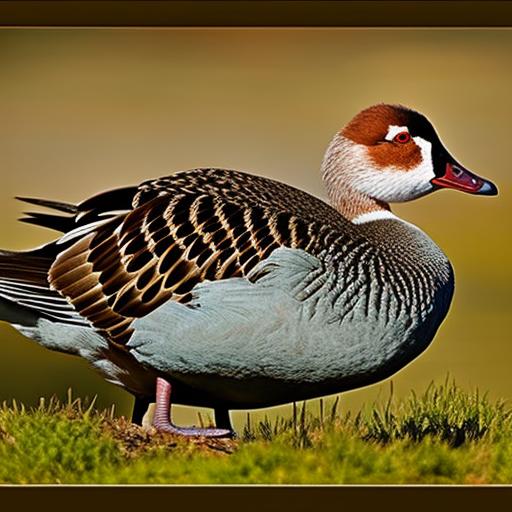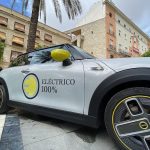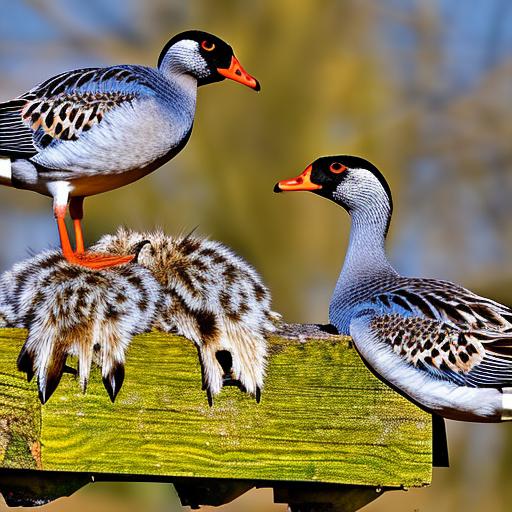Geese are a diverse group of waterfowl that belong to the family Anatidae. There are over 50 different breeds of geese, each with its own unique characteristics and traits. These breeds can be categorized into three main groups: domestic geese, wild geese, and ornamental geese. Domestic geese are bred for their meat, eggs, and feathers, while wild geese are found in their natural habitats and are often hunted for sport. Ornamental geese, on the other hand, are bred for their aesthetic appeal and are often kept as pets or for exhibition purposes.
Each breed of geese has its own distinct physical characteristics, behavioral traits, vocalizations, and adaptation to different environments. Understanding the diversity of geese breeds is important for breeders, conservationists, and enthusiasts alike, as it allows for the preservation and promotion of these unique birds.
The Distinct Physical Characteristics of Different Geese Breeds
Geese breeds come in a wide variety of sizes, shapes, and colors. Some breeds, such as the Toulouse and Embden, are large and heavy-bodied, while others, like the Chinese and African, are smaller and more slender. The physical characteristics of geese breeds also vary in terms of plumage color and patterns. For example, the Sebastopol breed is known for its curly feathers, while the Pilgrim breed is characterized by its sex-linked coloration, with males and females having different plumage colors.
In addition to size and plumage, different geese breeds also have distinct facial features, such as bill shape and eye color. For example, the Chinese breed is known for its distinctive knob at the base of its bill, while the Roman breed has a prominent knob at the top of its bill. These physical characteristics not only make each breed visually unique but also serve specific purposes in terms of feeding, mating, and defense.
Exploring the Behavioral Traits of Various Geese Breeds
Geese breeds exhibit a wide range of behavioral traits that are influenced by their genetic makeup and environmental factors. Some breeds are known for their docile and friendly nature, making them ideal for domestication and interaction with humans. Others, such as the African and Chinese breeds, are more independent and can be more challenging to handle.
In addition to temperament, different geese breeds also have varying levels of aggression and territoriality. For example, the Embden breed is known for its protective nature and can be aggressive towards intruders, while the Pilgrim breed is more laid-back and less likely to exhibit aggressive behavior.
Furthermore, geese breeds also display unique mating and nesting behaviors. Some breeds are known for their monogamous mating habits, while others are more promiscuous. Understanding these behavioral traits is important for breeders and enthusiasts to ensure the well-being and proper management of different geese breeds.
The Unique Vocalizations and Communication Styles of Different Geese Breeds
Geese are highly vocal birds that use a variety of vocalizations to communicate with each other. Each breed of geese has its own unique vocalizations and communication styles that serve different purposes in their social interactions. For example, the Chinese breed is known for its loud and raucous calls, while the Toulouse breed has a more melodious and musical vocalization.
In addition to vocalizations, geese breeds also use body language and physical gestures to communicate with each other. These communication styles can vary depending on the breed and can include head bobbing, wing flapping, and bill snapping. Understanding these communication styles is important for breeders and enthusiasts to interpret the behavior and needs of different geese breeds.
Geese Breeds and Their Adaptation to Different Environments
Geese breeds have evolved to adapt to a wide range of environments, from wetlands and marshes to grasslands and urban areas. Different breeds have developed specific adaptations to thrive in their respective habitats, such as webbed feet for swimming and foraging in water bodies or strong legs for walking long distances on land.
Furthermore, geese breeds also exhibit varying levels of cold tolerance, with some breeds being better suited for colder climates while others thrive in warmer regions. Understanding these adaptations is important for conservationists and breeders to ensure the proper management and conservation of different geese breeds in their natural habitats.
The Cultural and Historical Significance of Different Geese Breeds
Geese have played a significant role in human history and culture for thousands of years. Different geese breeds have been valued for their meat, eggs, feathers, and down, making them an important source of food and materials for various cultures around the world. In addition to their practical uses, geese have also been revered in folklore, mythology, and art, symbolizing loyalty, vigilance, and protection.
Furthermore, geese breeds have been selectively bred for specific traits and purposes throughout history, leading to the development of distinct breeds with unique characteristics. For example, the Chinese breed was bred for its meat production, while the Toulouse breed was developed for its large size and rapid growth rate. Understanding the cultural and historical significance of different geese breeds is important for preserving their heritage and promoting their continued relevance in modern society.
Conservation Efforts and the Future of Different Geese Breeds
Conservation efforts play a crucial role in ensuring the survival and well-being of different geese breeds. Many wild geese species are facing threats such as habitat loss, pollution, hunting, and climate change, leading to declining populations in their natural habitats. In addition to wild geese, some domestic geese breeds are also at risk of extinction due to changes in agricultural practices and declining interest in traditional livestock breeds.
Conservationists are working to protect and preserve different geese breeds through various initiatives such as habitat restoration, captive breeding programs, genetic diversity conservation, and public awareness campaigns. These efforts aim to safeguard the future of different geese breeds and promote their conservation as valuable genetic resources for future generations.
In conclusion, understanding the diversity of geese breeds is essential for appreciating their unique characteristics, behaviors, adaptations, cultural significance, and conservation needs. By recognizing the distinct physical traits, behavioral patterns, vocalizations, environmental adaptations, cultural significance, and conservation efforts of different geese breeds, we can ensure the preservation and promotion of these remarkable birds for generations to come.
Meet Walter, the feathered-friend fanatic of Florida! Nestled in the sunshine state, Walter struts through life with his feathered companions, clucking his way to happiness. With a coop that’s fancier than a five-star hotel, he’s the Don Juan of the chicken world. When he’s not teaching his hens to do the cha-cha, you’ll find him in a heated debate with his prized rooster, Sir Clucks-a-Lot. Walter’s poultry passion is no yolk; he’s the sunny-side-up guy you never knew you needed in your flock of friends!







